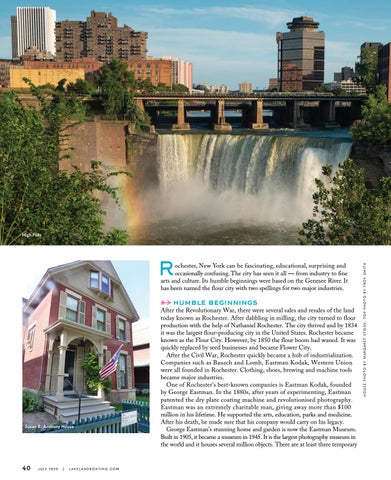R
ochester, New York can be fascinating, educational, surprising and occasionally confusing. The city has seen it all — from industry to fine arts and culture. Its humble beginnings were based on the Genesee River. It has been named the flour city with two spellings for two major industries.
humble beginnings
Susan B. Anthony House
40
J U LY 2 0 2 0
|
LAKELANDBOATING.COM
After the Revolutionary War, there were several sales and resales of the land today known as Rochester. After dabbling in milling, the city turned to flour production with the help of Nathaniel Rochester. The city thrived and by 1834 it was the largest flour-producing city in the United States. Rochester became known as the Flour City. However, by 1850 the flour boom had waned. It was quickly replaced by seed businesses and became Flower City. After the Civil War, Rochester quickly became a hub of industrialization. Companies such as Bausch and Lomb, Eastman Kodak, Western Union were all founded in Rochester. Clothing, shoes, brewing and machine tools became major industries. One of Rochester’s best-known companies is Eastman Kodak, founded by George Eastman. In the 1880s, after years of experimenting, Eastman patented the dry plate coating machine and revolutionised photography. Eastman was an extremely charitable man, giving away more than $100 million in his lifetime. He supported the arts, education, parks and medicine. After his death, he made sure that his company would carry on his legacy. George Eastman’s stunning home and garden is now the Eastman Museum. Built in 1905, it became a museum in 1945. It is the largest photography museum in the world and it houses several million objects. There are at least three temporary
HOUSE PHOTO BY MARGARET STEISS; TOP PHOTO BY TROY SMITH
High Falls
